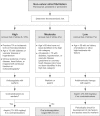Management of atrial fibrillation
- PMID: 17583181
- PMCID: PMC1994040
Management of atrial fibrillation
Abstract
Atrial fibrillation (AF) is a condition of genuine clinical concern. This arrhythmia increases patient morbidity and mortality, most notably due to stroke, thromboembolism and heart failure. Consequentially, there is a strong impetus to acquire a greater understanding of its natural history and course in order to provide crucial evidence-based treatment and resource allocation in the future. The objective of this review article is to present a concise overview of the management of AF, with reference to the recent evidence-based National Institute of Clinical Excellence (NICE) National Clinical Guidelines for the management of AF.
Figures

Similar articles
-
Management of atrial fibrillation.Lancet. 2007 Aug 18;370(9587):604-18. doi: 10.1016/S0140-6736(07)61300-2. Lancet. 2007. PMID: 17707756 Review.
-
Atrial fibrillation and acute decompensated heart failure.Circ Heart Fail. 2009 Jan;2(1):72-3. doi: 10.1161/CIRCHEARTFAILURE.108.830349. Circ Heart Fail. 2009. PMID: 19808318 Review. No abstract available.
-
Electrical and pharmacologic cardioversion for atrial fibrillation.Cardiol Clin. 2009 Feb;27(1):95-107, ix. doi: 10.1016/j.ccl.2008.09.008. Cardiol Clin. 2009. PMID: 19111767 Review.
-
[On the strategy of treatment of atrial fibrillation in the elderly (a response to the article "Ciliary arrhythmia" by M. A. Gurevich)].Klin Med (Mosk). 2006;84(9):65-6. Klin Med (Mosk). 2006. PMID: 17209452 Review. Russian. No abstract available.
-
Electrical and pharmacologic cardioversion for atrial fibrillation.Med Clin North Am. 2008 Jan;92(1):101-20, xi. doi: 10.1016/j.mcna.2007.08.003. Med Clin North Am. 2008. PMID: 18061000 Review.
Cited by
-
Racial disparities in awareness and treatment of atrial fibrillation: the REasons for Geographic and Racial Differences in Stroke (REGARDS) study.Stroke. 2010 Apr;41(4):581-7. doi: 10.1161/STROKEAHA.109.573907. Epub 2010 Feb 26. Stroke. 2010. PMID: 20190000 Free PMC article.
-
Subject-specific factors affecting particle residence time distribution of left atrial appendage in atrial fibrillation: A computational model-based study.Front Cardiovasc Med. 2023 Mar 13;10:1070498. doi: 10.3389/fcvm.2023.1070498. eCollection 2023. Front Cardiovasc Med. 2023. PMID: 36993996 Free PMC article.
-
Epidemiology and Management of Atrial Fibrillation and Stroke: Review of Data from Four European Countries.Stroke Res Treat. 2017;2017:8593207. doi: 10.1155/2017/8593207. Epub 2017 May 28. Stroke Res Treat. 2017. PMID: 28634569 Free PMC article. Review.
-
Sex Differences in Severity of Stroke in the INSTRUCT Study: a Meta-Analysis of Individual Participant Data.J Am Heart Assoc. 2019 Jan 8;8(1):e010235. doi: 10.1161/JAHA.118.010235. J Am Heart Assoc. 2019. PMID: 30590965 Free PMC article.
-
Genome-Wide Copy Number Variation Association Study of Atrial Fibrillation Related Thromboembolic Stroke.J Clin Med. 2019 Mar 9;8(3):332. doi: 10.3390/jcm8030332. J Clin Med. 2019. PMID: 30857284 Free PMC article.
References
-
- Alboni P, Botto GL, Baldi NL, et al. Outpatient treatment of recent-onset atrial fibrillation with the “pill-in-the-pocket” approach. N Eng J Med. 2004;351:2384–91. - PubMed
-
- Antonielli E, Pizzuti A, Palinkas A, et al. Clinical value of left atrial appendage flow for prediction of long-term sinus rhythm maintenance in patients with nonvalvular atrial fibrillation. J Am Coll Cardiol. 39:1443–9. - PubMed
-
- Aronow WS, Ahn C, Kronzon I, et al. Risk factors for new thromboembolic stroke in patients ≥62 years of age with chronic atrial fibrillation. Am J Cardiol. 1998;82:119–21. - PubMed
-
- Benavente O, Hart R, Koudstaal P, et al. Oral anticoagulants for preventing stroke in patients with non-valvular atrial fibrillation and no previous history of stroke or transient ischemic attacks. The Cochrane Library. 2003 - PubMed
Publication types
MeSH terms
Substances
LinkOut - more resources
Full Text Sources
Medical

